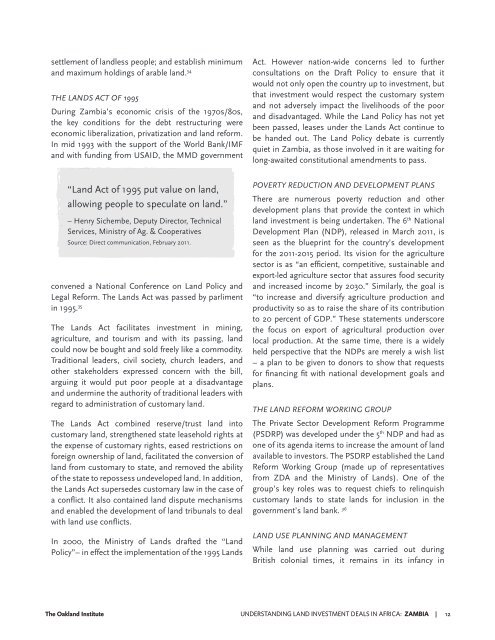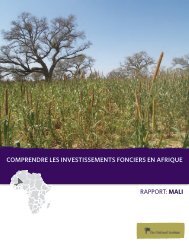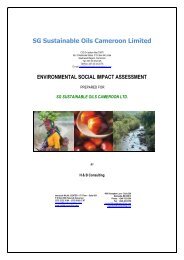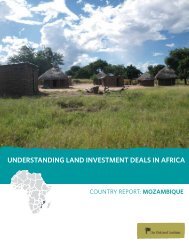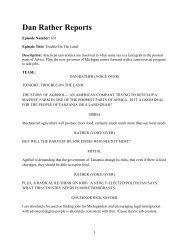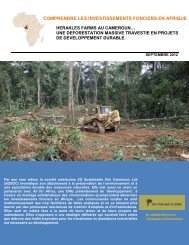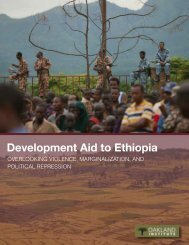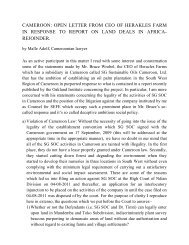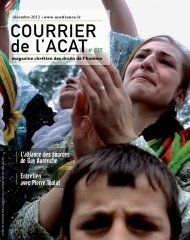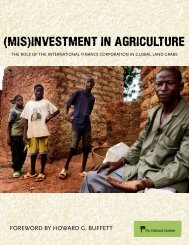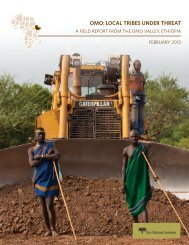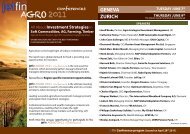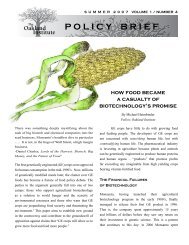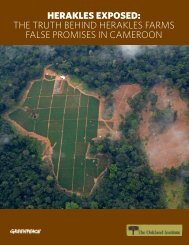Zambia - Oakland Institute
Zambia - Oakland Institute
Zambia - Oakland Institute
Create successful ePaper yourself
Turn your PDF publications into a flip-book with our unique Google optimized e-Paper software.
settlement of landless people; and establish minimum<br />
and maximum holdings of arable land. 34<br />
THE LANDS ACT OF 1995<br />
During <strong>Zambia</strong>’s economic crisis of the 1970s/80s,<br />
the key conditions for the debt restructuring were<br />
economic liberalization, privatization and land reform.<br />
In mid 1993 with the support of the World Bank/IMF<br />
and with funding from USAID, the MMD government<br />
Act. However nation-wide concerns led to further<br />
consultations on the Draft Policy to ensure that it<br />
would not only open the country up to investment, but<br />
that investment would respect the customary system<br />
and not adversely impact the livelihoods of the poor<br />
and disadvantaged. While the Land Policy has not yet<br />
been passed, leases under the Lands Act continue to<br />
be handed out. The Land Policy debate is currently<br />
quiet in <strong>Zambia</strong>, as those involved in it are waiting for<br />
long-awaited constitutional amendments to pass.<br />
“Land Act of 1995 put value on land,<br />
allowing people to speculate on land.”<br />
– Henry Sichembe, Deputy Director, Technical<br />
Services, Ministry of Ag. & Cooperatives<br />
Source: Direct communication, February 2011.<br />
convened a National Conference on Land Policy and<br />
Legal Reform. The Lands Act was passed by parliment<br />
in 1995. 35<br />
The Lands Act facilitates investment in mining,<br />
agriculture, and tourism and with its passing, land<br />
could now be bought and sold freely like a commodity.<br />
Traditional leaders, civil society, church leaders, and<br />
other stakeholders expressed concern with the bill,<br />
arguing it would put poor people at a disadvantage<br />
and undermine the authority of traditional leaders with<br />
regard to administration of customary land.<br />
The Lands Act combined reserve/trust land into<br />
customary land, strengthened state leasehold rights at<br />
the expense of customary rights, eased restrictions on<br />
foreign ownership of land, facilitated the conversion of<br />
land from customary to state, and removed the ability<br />
of the state to repossess undeveloped land. In addition,<br />
the Lands Act supersedes customary law in the case of<br />
a conflict. It also contained land dispute mechanisms<br />
and enabled the development of land tribunals to deal<br />
with land use conflicts.<br />
In 2000, the Ministry of Lands drafted the “Land<br />
Policy”– in effect the implementation of the 1995 Lands<br />
POVERTY REDUCTION AND DEVELOPMENT PLANS<br />
There are numerous poverty reduction and other<br />
development plans that provide the context in which<br />
land investment is being undertaken. The 6 th National<br />
Development Plan (NDP), released in March 2011, is<br />
seen as the blueprint for the country’s development<br />
for the 2011-2015 period. Its vision for the agriculture<br />
sector is as “an efficient, competitive, sustainable and<br />
export-led agriculture sector that assures food security<br />
and increased income by 2030.” Similarly, the goal is<br />
“to increase and diversify agriculture production and<br />
productivity so as to raise the share of its contribution<br />
to 20 percent of GDP.” These statements underscore<br />
the focus on export of agricultural production over<br />
local production. At the same time, there is a widely<br />
held perspective that the NDPs are merely a wish list<br />
– a plan to be given to donors to show that requests<br />
for financing fit with national development goals and<br />
plans.<br />
THE LAND REFORM WORKING GROUP<br />
The Private Sector Development Reform Programme<br />
(PSDRP) was developed under the 5 th NDP and had as<br />
one of its agenda items to increase the amount of land<br />
available to investors. The PSDRP established the Land<br />
Reform Working Group (made up of representatives<br />
from ZDA and the Ministry of Lands). One of the<br />
group’s key roles was to request chiefs to relinquish<br />
customary lands to state lands for inclusion in the<br />
government’s land bank. 36<br />
LAND USE PLANNING AND MANAGEMENT<br />
While land use planning was carried out during<br />
British colonial times, it remains in its infancy in<br />
The <strong>Oakland</strong> <strong>Institute</strong> UNDERSTANDING LAND INVESTMENT DEALS IN AFRICA: ZAMBIA | 12


